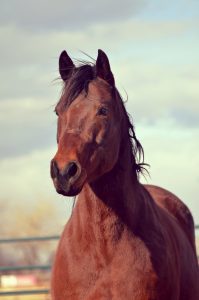Within our last few articles, we discussed the amazing amount of progress that each of our horses had made while enrolled in our training program. Today, I would like to start our case study from the very beginning, focusing on a particularly interesting mare: Fern. The Colorado Horse Rescue was able to save this stocky quarter horse mare from a local livestock auction visited regularly by kill buyers. Like most horses saved from auction, we were given no indication of her history. Rather, we were left to decipher her background as she eventually settled in at the Rescue. Once some time had passed and we were able to perform a quick groundwork evaluation, we knew immediately that we had our hands more than full!
All animals are born with “fight or flight” instincts, which are necessary to ensure their survival in the wild. Horses, being prey animals, generally lean heavier on the “flight” impulse in order to escape predators and only resort to the “fight” impulse when they feel trapped and there is no other option. Even domestic equines hold onto this instinct when learning to move away from pressure where trainers can leverage this understanding to help communicate with their horses. Fern, perhaps due to poor handling or misuse, had a much higher “fight” instinct and very little flight. Asking for even the smallest movement would result in ears being pinned straight back, tail swishing in warning, quickly followed by a forceful kick towards her handlers. When introduced to a saddle or pad simply to investigate, she would charge or bite at the object. As always, this attitude could have developed due to an immense number of factors likely related to what her past had looked like. Taking our understanding of why a horse resorts to aggression, we can speculate that this started out from a sense of being under threat. That sense may have built up to the point that moving away from pressure was no longer working to give her peace or wasn’t even an option given to her.
As with many of the horses that we have talked about on this blog, using the general training methods did not seem to be the way to make a positive impact towards rehabbing Fern. Instead, we chose to think outside of the box in order to make training sessions something that she would willingly want to participate in while also developing safer habits when she does feel under stress. We use our training program to do more than push our horses into a riding career. Instead, we go levels deeper and try to work with the psychology behind why they do what they do. We do this by finding personalized methods to aid each horse in improving their mental health when they are struggling with being shut down, anxious, or even, in Fern’s case, angry. This approach paves the way for each horse to continue on their journey towards a safe adoption. A large part of that program is the use of treat training to help these horses engage eagerly with the trainers, and have each instruction be something that they want to participate in. When done properly, this type of training can quickly change a horse’s mindset around people and what they mean to them. In Fern’s case, it will potentially mean that she may start to look at training sessions as something to enjoy and that will help her understand that listening to pressure doesn’t have to be an overreaction that automatically kicks in her “fight” instinct.
With all of this background, please stay tuned for Fern’s next chapter where we will be discussing her progress in her training journey!
